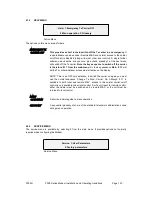
P300H
P300 Series Modem Installation and Operating Handbook
Page 147
For other values of overhead (o/h expressed as 1.xx), maximise `t` then:
n
= Round( (2 x o/h x t) / (o/h - 1) )
k
= n - 2t
If `n` is greater than 255, reduce `t`.
For some applications, particularly when operating with lower data rates, a reduction in the processing
delay associated with Reed-Solomon FEC is the prime goal. In such circumstances use the `Custom
Features` feature and select shorter codewords to reduce the encoder / decoder & interleaver / de-
interleaver delay. For example switching from INTELSAT standard values of n, k, t = 126, 112, 7 to 64,
56, 4 provides approximately the same correction ability (7 in 126 = 5.5% and 4 in 64 = 6.25%
respectively), with similar overheads (126/112=12.5%, 64/56=14.3%), but with interleaving & decoder
delays reduced from 5632 to 3104 bits (156ms to 85ms at 32kbps). If using Sequential FEC, see also
`Fault Mode = 3` in Appendix E.
8.5 NOTES ON DATA RATES & SYMBOL RATES
The normal constraint for a modem is the range of
Symbol Rates
over which the modem can operate
correctly. The Symbol Rate range however is not of initial interest to most modem users, as they first
need to know if the modem can operate at the terrestrial
Data Rate
they require. This section briefly
explains the relationship between Data Rates and Symbol Rates.
The
Data Rate
is normally the frequency of the clock used on the terrestrial port however if
Drop/Insert is active the Data Rate is 64kbps times the number of timeslots dropped/Inserted.
As the P300 Series Modem use PSK (Phase Shift Keying) the
Symbol Rate
is the rate of
phase
changes
on the I.F. signal. Each phase change represents a new symbol to the demodulator, and
depending on the modulation scheme that symbol may convey one (BPSK), two (QPSK), or three
(8PSK) bits of information.
The diagram below shows how the symbol rate is built up from the data rate.
You will see that with 1/2 rate FEC and QPSK (a common combination), the Symbol Rate is the same as
the Data Rate (assuming no Framing or Reed-Solomon). This is a useful combination to check on any
data sheet, as this will give you the Symbol Rate limits of the modem, from which the Data Rate limits in
all other modes and combinations can normally be derived.
Содержание P300 Series
Страница 21: ...P300H P300 Series Modem Installation and Operating Handbook Page 21 F BLOCK DIAGRAM ...
Страница 22: ...P300H P300 Series Modem Installation and Operating Handbook Page 22 ...
Страница 163: ...P300H P300 Series Modem Installation and Operating Handbook Page 163 8 12 4 Eb No Explanatory Diagram ...














































